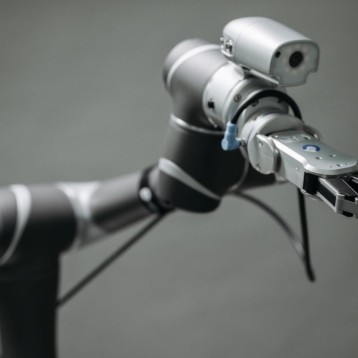The Whegs series robots were inspired by its predecessors; PROLERO (Prototype of Legged Rover) is a six-legged robot with six drive motors, which was designed in 1996 by A. Martin Alvarez at the European Space Agency. RHex (2000) uses a total of 6 motors and spoke-like legs and was the result of a multidisciplinary and multi-university DARPA funded effort in Computational Neuromechanics.
Whegs is a 20-inches long robot that utilizes three-spoke wheel-legs and one drive motor. It moves at speeds of up to a 3 body lengths/second (5.5km/hr) and can climb over obstacles up to 1.5 times higher than its wheel-leg radius. The Autonomous Whegs II is an improved model, capable of climbing higher obstacles thanks to a built-in body joint. In addition, it is equipped with sensors, low-computational power microcontrollers, and basic insect-like behaviors that enable it to autonomously navigate its environment. A short video of Whegs II in action can be found here.
The Mini-Whegs robot is only 8-9 cm long and is capable of ‘running’ at sustained speeds of over 10 body lengths per second while navigating through rough terrain. Much like the full-sized Whegs robot, the Mini-Whegs moves in a diagonal gait as two of the wheel-legs are in phase with each other, but 60 degrees out of phase with the other two legs. The front legs come back into phase with each other in order to pull the robot up when encountering obstacles.
The Climbing Mini-Whegs is a four-wheel-legged robot with compliant, adhesive feet and one drive motor, which can climb vertical glass surfaces using its long tail. A shorter tail is required when traversing a 60-degree incline. The robot uses a novel adhesive manufactured by the Gottlieb Binder Company in collaboration with the Max-Planck Institute. A short video is available here.
TFOT has previously covered another climbing robot – the Tri-Leg Waalbot – capable of simple surface locomotion and inspired by geckos that use tiny fibers located on their feet to adhere to almost any surface. TFOT also covered OmniTread – a snake-like robot capable of climbing high vertical obstacles such as stairs, moving through rough terrain, and crossing over wide gaps.
More information about the Whegs Robots is available at the Biologically Inspired Robotics Laboratory’s official website.










